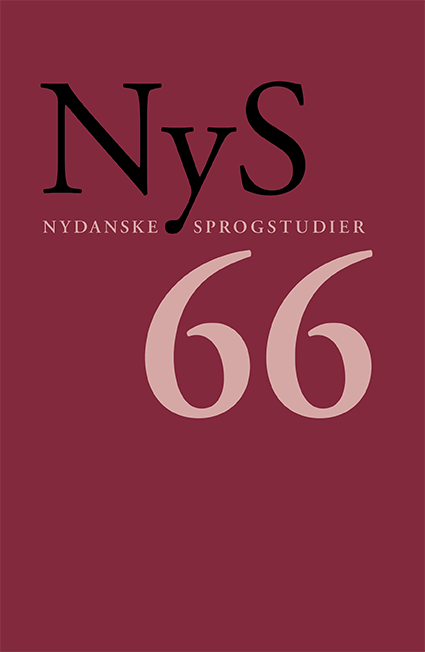Inverse Case Attraction in Danish, Norwegian and Swedish
DOI:
https://doi.org/10.7146/nys.v1i66.146880Keywords:
case, attraction, relative clause, writing, ScandinavianAbstract
This article compares the distribution of case forms in 3p.pl. pronouns with a restrictive relative clause (e.g. de/dem der larmer ‘they/them who are noisy’) in Danish, Norwegian Bokmål and Swedish. The comparison is based on two new studies of pronoun case in subjects and complements to the preposition til/till (‘to’) in Norwegian and Swedish, alongside selected results from three previous studies of pronoun case in the {PRONOUN + RELATIVE CLAUSE} construction in Danish. The article discusses the rules as presented in standard grammars, assessing that the explanations for the use of the nominative case instead of the oblique case – which is expected according to the main rule – are insufficient. The so-called article analyses is rejected, and it is argued that the use of the nominative case in prepositional complements is best explained as instances of inverse case attraction. In subjects, however, there is no reason to assume anything other than the main rule in Norwegian and Swedish, and in Danish, the use of oblique case in subjects is better explained by rules other than inverse case attraction.
References
Abney, S.P. 1987. The English noun phrase in its sentential aspect. Ph.d-afhandling. Massachusetts Institute of Technology, Dept. of Linguistics and Philosophy.
Andersen, G. & Hofland, K. 2012. Building a large corpus based on newspapers from the web. G. Andersen (red.), Exploring newspaper language: Using the web to create and investigate a large corpus of modern Norwegian (Studies in Corpus Linguistics 49), 1–28. Amsterdam/Philadelphia: John Benjamins Publishing Company. DOI: https://doi.org/10.1075/scl.49.
Becker-Christensen, C. 2010. Dansk syntaks. Indføring i dansk sætningsgrammatik og sætningsanalyse. Frederiksberg: Samfundslitteratur.
Bianchi, V. 1999. Consequences of antisymmetry. Headed relative clauses. (Studies in generative grammar 46). Berlin/New York: Mouton de Gruyter. DOI: https://doi.org/10.1515/9783110803372.
Brink, L. & J. Lund. 1975. Dansk rigsmål, bind 2. København: Gyldendal.
Christensen, L.H. & R.Z. Christensen. 2016. Dansk grammatik. 3. udgave. Odense: Syddansk Universitetsforlag.
Czypionka, A., L. Dörre & J. Bayer. 2018. Inverse case attraction: experimental evidence for a syntactically guided process. The journal of comparative Germanic linguistics 21(2). 135–188. DOI: https://doi.org/10.1007/s10828-018-9099-3.
Diderichsen, P. 1957 [1946]. Elementær dansk grammatik. 2. udgave. København: Gyldendal.
Faarlund, J.T., S. Lie & K.I. Vannebo. 1997. Norsk referansegrammatikk [= NRG]. Oslo: Universitetsforlaget.
Grimm, S. 2007. Case attraction in ancient Greek. B.D. ten Cate & H.W. Zeevat (red.), Logic, language, and computation. Lecture notes in computer science (4363), 139–153. Berlin/Heidelberg: Springer. DOI: https://doi.org/10.1007/978-3-540-75144-1_11.
Hansen, E. & L. Heltoft. 2019 [2011]. Grammatik over det danske sprog [= GDS], bind 1–3. 2. udgave. København/Odense: Det Danske Sprog- og Litteraturselskab & Syddansk Universitetsforlag.
Heltoft, L. 1997. Hvem opslugte hvo. Et bidrag til beskrivelsen af det danske kasussystems udvikling. F. Lundgreen-Nielsen, M.A. Nielsen & J.S. Sørensen (red.), Ord, Sprog oc artige Dict. Et overblik og 28 indblik 1500–1700. Festskrift til Poul Lindegård Hjorth, 227–256. København: Universitets-Jubilæets danske Samfund & C.A. Reitzel.
Jensen, E.S., J. Schack & J.H. Petersen. 2023. The use of case forms in modern Danish – an empirical study. Acta linguistica Hafniensia 55(2). 182–215. DOI: https://doi.org/10.1080/03740463.2023.2290892.
Johannsen, O.R. 2024. Kasus i hypotagmer. En undersøgelse af flertalspronomenerne. Ny forskning i grammatik 31. 88–106. DOI: https://doi.org/10.7146/nfg.v1i31.145294.
Jørgensen, H. 2021. Man og en – paradigme eller ej? M.H. Andersen & E.S. Jensen (red.), Med fornøden agtelse. Festskrift til Jørgen Schack på 60-årsdagen 14. maj 2021, 185–196. Bogense: Dansk Sprognævn.
Mikkelsen, K. 1975 [1911]. Dansk Ordföjningslære med sproghistoriske Tillæg. Håndbog for viderekomne og Lærere. Genudgivelse. København: Hans Reitzel.
Petersen, J.H., J. Schack & E.S. Jensen. 2020. Pronominalkasus i subjekt med bestemmende relativsætning. Ny forskning i grammatik 27. 108–124. DOI: https://doi.org/10.7146/nfg.v0i27.122134.
Schack, J. 2013. Dig og mig og vi to. Synspunkter på kasus i moderne dansk. NyS – Nydanske sprogstudier 45. 48–72. DOI: https://doi.org/10.7146/nys.v45i45.16904.
Schack, J., E.S. Jensen & J.H. Petersen. 2019. ”Tak til alle de der gør en indsats for vores sikkerhed”. Bagom dronningens kasusvalg. Y. Goldshtein, I. Schoonderbeek & T.T. Hougaard (red.), Møde om Udforskningen af Dansk Sprog 17, 443–456. Århus: Aarhus Universitet.
Sigurðsson, H.A. 2006. The nom/acc alternation in Germanic. J. Harmann & L. Molfárni (red.), Comparative studies in Germanic syntax. From Afrikaans to Zurich German (Linguistics Today 97), 13–50. Amsterdam: John Benjamins. DOI: https://doi.org/10.1075/la.97.03sig.
Teleman, U., S. Hellberg & E. Andersson. 1999. Svenska Akademiens grammatik [= SAG]. Stockholm: Svenska Akademien.
Wood, J., E.F. Sigurðsson & I.E. Nowenstein. 2017. Inverse attraction in Icelandic relative clauses. H. Thráinsson, C. Heycock, H.P. Petersen & Z.S. Hansen (red.), Syntactic variation in insular Scandinavian (Studies in Germanic linguistics 1), 199–232. Amsterdam: John Benjamins. DOI: https://doi.org/10.1075/sigl.1.08woo.
Downloads
Published
How to Cite
Issue
Section
License
Forfatteren/forfatterne og NyS har ophavsret til de artikler og anmeldelser der bringes i tidsskriftet. NyS har ophavsretten til den udgivne version af tidsskriftet. Forfatteren har ophavsretten til sin egen tekst. Forfattere kan arkivere den publicerede artikel på deres institutions forskningsarkiv (Institutional Repository) eller en privat hjemmeside, når forfatteren samtidig linker til artiklen med den officielle DOI.
For artikler publiceret i NyS tillades at læsere kan downloade, kopiere, udskrive, søge eller linke til og citere fra artikler til ethvert lovligt formål. Artikler kan frit deles og linkes til på forsknings- og undervisningsnetværk (så som Blackboard, Moodle, Canvas o.a.). Link foretrækkes fordi det giver oplysning om brug af tidsskriftets artikler, og fordi det anerkender tidsskriftets redaktionelle arbejde. NyS tillader ikke at læsere bruger artikler eller dele af dem i egne artikler uden at citere, eller at læsere på anden vis anvender dem til kommercielle formål.





